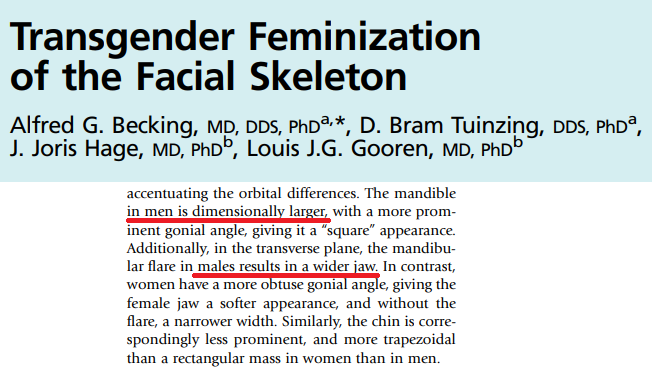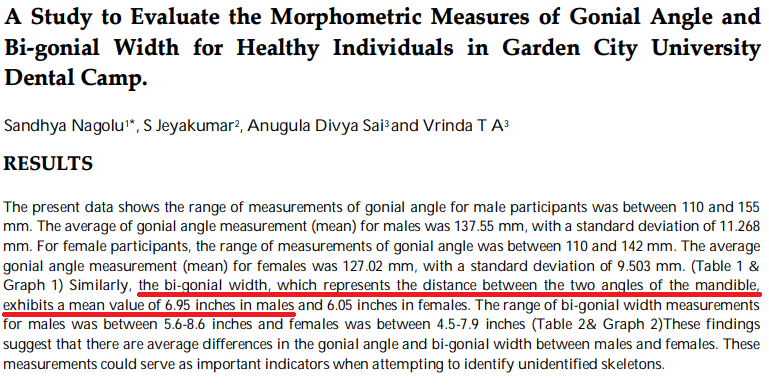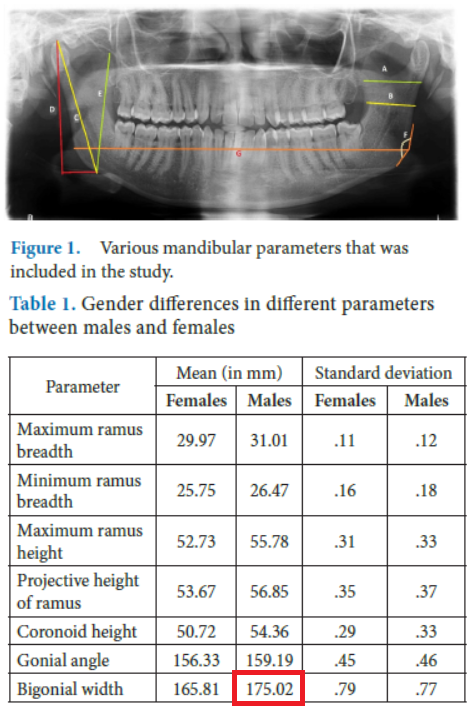Summary
A larger bi-gonial width is attractive for males as it contributes to a strong, masculine jawline. Research supports this trait’s association with masculinity and attractiveness. A study by Sandhya Nagolu et al. at Garden City University found that the mean bi-gonial width for males was 176.53 mm (6.95 inches). Similarly, a study by D. B. Meleveetil et al. analysed 500 participants and reported that males had a mean bi-gonial width of 175.02 mm. Another study titled “Transgender Feminization of the Facial Skeleton” highlights that the mandible in males is dimensionally larger, with prominent gonial angles and greater mandibular flare, which results in a wider bi-gonial width. These findings demonstrate that a larger bi-gonial width is a key feature linked to masculinity, signaling dominance and strength, qualities often associated with male attractiveness.
Research
Facial structure significantly impacts attractiveness, with a larger bi-gonial width, the distance between the two gonial angles, contributing to a stronger, more masculine appearance. According to the study “Transgender Feminization of the Facial Skeleton“ “the mandible in men is dimensionally larger, with a more prominent gonial angle, giving it a ‘square’ appearance. Additionally, in the transverse plane, the mandibular flare in males results in a wider jaw.” This broader jawline signals strength, dominance, and masculinity, traits often associated with attractiveness in males.

A study was conducted at a dental camp organized by Garden City University, Bangalore. The study involved 152 participants, including 74 males and 78 females, aged between 18 and 30 years. It measured bi-gonial width and found that males had a mean bi-gonial width of 6.95 inches (approximately 176.53 mm), with a range between 142.24 mm (5.6 inches) and 218.44 mm (8.6 inches) highlighting that males tend to have a wider jaw, a key trait associated with masculinity and attractiveness.

Another study titled “Mandibular Ramus: An Indicator of Gender and Chronological Age – A Digital Radiographic Study“ examined digital orthopantomographs (OPGs) of 500 participants to assess various mandibular measurements for gender estimation. One key finding was that the mean bi-gonial width for males was 175.02 mm, compared to 165.81 mm for females, demonstrating a significant difference. This supports the idea that a broader jaw, reflected by a larger bi-gonial width, is a defining masculine trait associated with strength and attractiveness.

References
Becking, A. G., Tuinzing, D. B., Hage, J. J., & Gooren, L. J. (2007). Transgender feminization of the facial skeleton. Clinics in plastic surgery, 34(3), 557-564. https://www.sciencedirect.com/science/article/abs/pii/S0094129807000673
Meleveetil, D. B., Beena, V. T., Cheriyan, L. M., Angamuthu, K., & Charapparambath, B. (2020). Mandibular Ramus: An Indicator of Gender and Chronological Age-A Digital Radiographic Study. Journal of Forensic Dental Sciences, 12(3), 158-164. https://journals.lww.com/jfds/fulltext/2020/12030/mandibular_ramus__an_indicator_of_gender_and.3.aspx
Nagolu, Jeyakumar, Sai and Vrinda T A, (2024) A Study to Evaluate the Morphometric Measures of Gonial Angle and Bi-gonial Width for Healthy Individuals in Garden City University Dental Camp. https://www.researchgate.net/profile/Sandhya-Nagolu/publication/384156862_A_Study_to_Evaluate_the_Morphometric_Measures_of_Gonial_Angle_and_Bi-gonial_Width_for_Healthy_Individuals_in_Garden_City_University_Dental_Camp/links/66ed083819c9496b1fae7332/A-Study-to-Evaluate-the-Morphometric-Measures-of-Gonial-Angle-and-Bi-gonial-Width-for-Healthy-Individuals-in-Garden-City-University-Dental-Camp.pdf